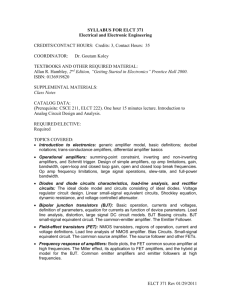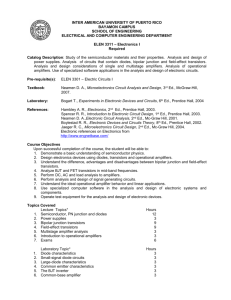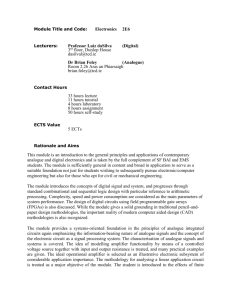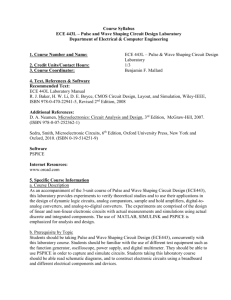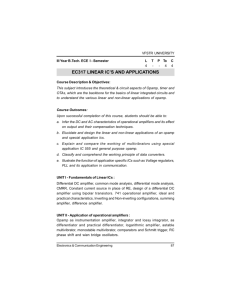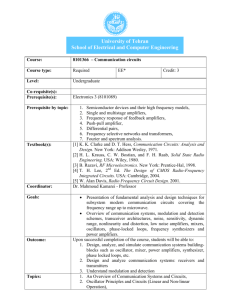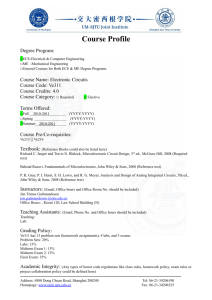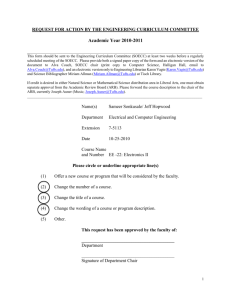AVT121 Principles of Solid State
advertisement
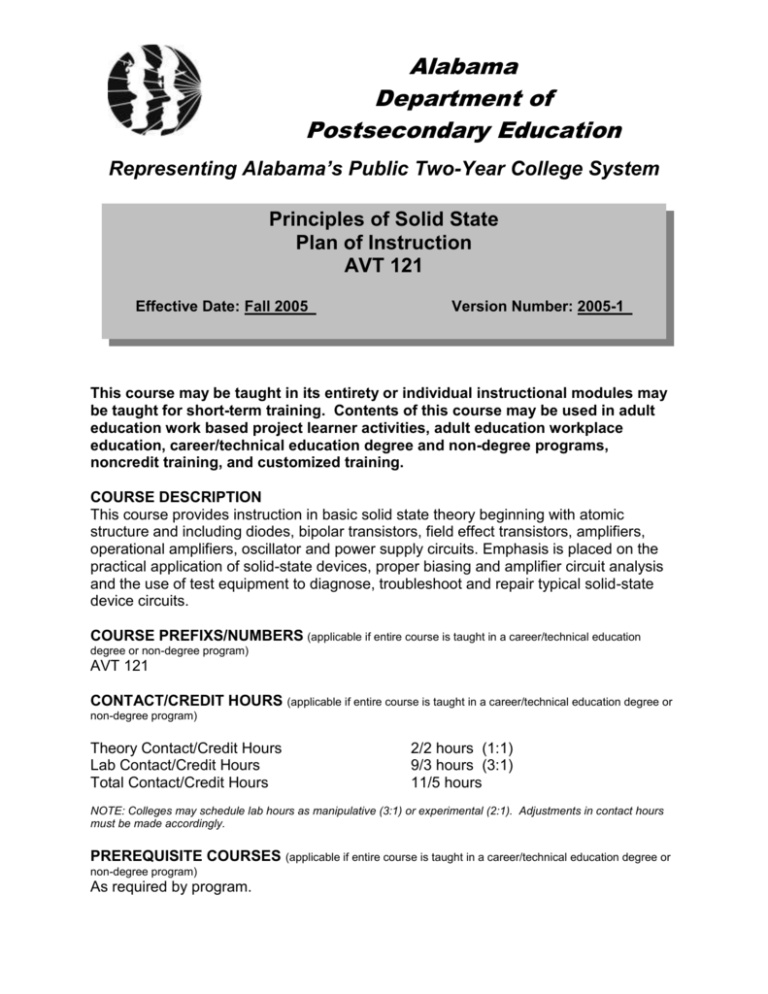
Alabama Department of Postsecondary Education Representing Alabama’s Public Two-Year College System Principles of Solid State Plan of Instruction AVT 121 Effective Date: Fall 2005 Version Number: 2005-1 This course may be taught in its entirety or individual instructional modules may be taught for short-term training. Contents of this course may be used in adult education work based project learner activities, adult education workplace education, career/technical education degree and non-degree programs, noncredit training, and customized training. COURSE DESCRIPTION This course provides instruction in basic solid state theory beginning with atomic structure and including diodes, bipolar transistors, field effect transistors, amplifiers, operational amplifiers, oscillator and power supply circuits. Emphasis is placed on the practical application of solid-state devices, proper biasing and amplifier circuit analysis and the use of test equipment to diagnose, troubleshoot and repair typical solid-state device circuits. COURSE PREFIXS/NUMBERS (applicable if entire course is taught in a career/technical education degree or non-degree program) AVT 121 CONTACT/CREDIT HOURS (applicable if entire course is taught in a career/technical education degree or non-degree program) Theory Contact/Credit Hours Lab Contact/Credit Hours Total Contact/Credit Hours 2/2 hours (1:1) 9/3 hours (3:1) 11/5 hours NOTE: Colleges may schedule lab hours as manipulative (3:1) or experimental (2:1). Adjustments in contact hours must be made accordingly. PREREQUISITE COURSES (applicable if entire course is taught in a career/technical education degree or non-degree program) As required by program. Avionics AVT 121 CO-REQUISITE COURSES (applicable if entire course is taught in a career/technical education degree or non-degree program) As required by program. PREREQUISITE KNOWLEDGE: The Avionics discipline is highly technical. Students desiring to enroll should demonstrate an ability to solve practical problems using the specific subject areas listed below. General Math including areas such as integers, percents, ratio and proportions, metric system, probability and linear equations. Advanced Math including areas such as Analytical Geometry and Trigonometry. Computers and Applications including areas such as the component parts, functions and software applications. Technical Writing including such areas as research, organization, composition, documentation, and presentation of a report. INDUSTRY COMPETENCIES Diagnose circuits containing solid-state devices Troubleshoot circuits containing solid-state devices Repair circuits containing solid-state devices COURSE OBJECTIVES The cognitive objective of this course is for each student to comprehend foundational knowledge needed to perform stated entry-level industry competencies. The performance objective of this course is for each student to apply foundational knowledge to electronic problems and exercises encountered in class. INDUSTRY COMPETENCIES AND CRITERION OBJECTIVES INDUSTRY CRITERION OBJECTIVES COMPETENCIES MODULE A: FOUNDATIONS OF SOLID STATE Diagnose circuits Given test equipment and solid-state circuit devices, containing solid-state diagnose the circuit and identify 70% of the requirements devices correctly. Locally identified Locally developed criterion objectives industry competencies MODULE B: POWER SUPPLIES AND AMPLIFIERS Diagnose circuits Given test equipment and solid-state circuit devices, containing solid-state diagnose the circuit and identify 70% of the requirements devices correctly. Locally identified Locally developed criterion objectives industry competencies 2 Avionics AVT 121 MODULE C: ADVANCED APPLICATIONS OF SOLID STATE Troubleshoot circuits Given an amplifier, a troubleshooting process, and test containing solid-state equipment, analyze the amplifier and correctly identify the devices malfunction. Given an oscillator and test equipment, test the oscillator for proper operation. Given linear integrated circuits and test equipment, troubleshoot the circuit and correctly identify the malfunction. Given electronic control devices and test equipment, troubleshoot the circuit and correctly identify the fault. Repair circuits containing solid-state devices Given a regulated power supply and test equipment, troubleshoot the unit and correctly identify the malfunction. Given an amplifier, wires, and circuit materials, construct an amplifier circuit, and then test the circuit for proper operation. Given an amplifier, wires, and circuit materials, construct a large signal amplifier then test the amplifier for proper operation. Locally identified industry competencies Given an operational amplifier and test equipment, test for proper operation. Locally developed criterion objectives ENABLING OBJECTIVES/KEY INDICATORS MODULE A: FOUNDATIONS OF SOLID STATE Define a semiconductor Identify different types of semiconductors Explain the function of semiconductors Define a basic diode Identify different types of diodes Explain basic operation of diodes Analyze operation of basic diodes using approximations Explain operation of basic diode circuits Analyze the operation of transistors using approximations Explain basic transistor circuits using network theorems 3 Avionics AVT 121 MODULE B: POWER SUPPLIES AND AMPLIFIERS Define an amplifier Identify different types of amplifiers Explain the function of an amplifier Explain basic amplifier circuits Explain the function of large signal amplifiers Explain the function of operational amplifiers MODULE C: ADVANCED APPLICATIONS OF SOLID STATE Describe amplifier troubleshooting Define an oscillator Explain operation of basic oscillator circuits Define a radio receiver Explain the operation of basic radio receivers Define a linear integrated circuit Explain the operation of basic linear integrated circuits Define electronic control devices Explain the operation of electronic control devices Define a regulated power supply Explain the operation of a regulated power supply Describe the process of constructing an amplifier COURSE CONTENT OUTLINE MODULE A: FOUNDATIONS OF SOLID STATE INTRODUCTION A brief history Digital and analog Analog functions Circuits with both DC and AC Trends in electronics SEMICONDUCTORS Conductors Semiconductors N-type P-type Majority and minority carriers JUNCTION DIODES PN junction Characteristic curves of diodes 4 Avionics AVT 121 Diode lead identification Diode types and applications MODULE B: POWER SUPPLIES AND AMPLIFIERS POWER SUPPLIES The power supply system Rectification Full wave rectification Conversion of RMS to Average Filters Voltage Multipliers Ripple and regulation Zener regulators Troubleshooting Replacement parts JUNCTION TRANSISTORS Amplification Transistors Characteristic curves Transistor data Transistor testing Other transistor types SMALL SIGNAL AMPLIFIERS Measuring gain Common emitter amplifier Stabilizing the amplifier Other configurations Amplifier coupling Voltage gain in coupled stages Field effect transistor amplifiers Negative feedback Frequency response LARGE SIGNAL AMPLIFIERS Amplifier class Class A power amplifiers Class B power amplifiers Class AB power amplifiers Class C power amplifiers OPERATIONAL AMPLIFIERS The differential amplifier 5 Avionics AVT 121 Operational amplifiers Setting Op-amp gain Frequency effects in op-amps Op-amp applications MODULE C ADVANCED APPLICATIONS OF SOLID STATE AMPLIFIER TROUBLESHOOTING Preliminary checks No Output Reduced output Distortion and noise Intermittents Operational amplifiers OSCILLATORS Oscillator characteristics RC circuits LC circuits Crystal circuits Relaxation oscillators Undesired oscillations Oscillator troubleshooting LINEAR INTEGRATED CIRCUITS Introduction Fabrication 555 timer Other applications Troubleshooting ELECTRONIC CONTROL DEVICES AND CIRCUITS Introduction The silicon-controlled rectifier Full wave devices Feedback in control circuitry Troubleshooting electronic control circuits REGULATED POWER SUPPLIES Open-loop voltage regulation Closed-loop voltage regulation Current and voltage limiting Switch-mode regulators Troubleshooting regulated power supplies 6 Avionics AVT 121 RECOMMENDED METHODS OF EVALUATION: The table of specifications below identifies the number of enabling objectives/key indicators per cognitive domain level of learning (Knowledge, Comprehension, Application) per module. The instructor should develop 1-3 test questions per Knowledge Level of Learning, 2-4 test questions per Comprehension Level of Learning, and 5-6 questions per Application Level Learning. The instructor should use the following test item types for each level of learning: Knowledge: Alternative response test items (true/false or yes/no) Comprehension: Multiple choice Application: Multiple choice, short answer exercises The table of specifications also identifies the number of criterion objectives per module (Psychomotor). The instructor should ensure each student meets the performance and standards published in each objective. Domain of Learning/ Content Module A Module B Module C Cognitive total Performance total TABLE OF SPECIFICATIONS Total Cognitive Domain Per Knowledge Comprehension Application Module 4 6 10 2 4 6 5 7 12 11 17 28 Psychomotor Domain 1 1 9 11 7 Avionics AVT 121 RECOMMENDED INSTRUCTIONAL METHODOLOGIES: The table below links the teaching methods and activities most effective for facilitating student achievement of learning outcomes published in this plan of instruction. Cognitive Level (Thinking) Knowledge Descriptive Verbs: Defines, Lists, States, Describes, Identifies Comprehension Descriptive Verbs: Describe, Explains, Summarizes Goal For Students Knows common terms, specific facts, methods, procedures, basic concepts, principles Understands facts and principles Interprets verbal material Interprets charts and graphs Teaching Methods Lecture Computer Based Instruction Video Demonstration Informal Lecture Discussion Demonstration Participation Interactive Computer Based Instruction Estimates future consequences Descriptive Verbs: Uses, Solves, Operates, Produces, Demonstrates, Constructs Applies laws and theories to practical situations 2. Explains and demonstrates concept, principle or procedure learned 4. Put students in a new situation, and the students solve the new situation using the concept, principle, or procedure while instructor supervises. Justifies methods and procedures Applies concepts and principles to new situations Mnemonics Examples or Illustrations Repetition Summaries Reviews 1. Teach to the Knowledge Level 3. Put students in new situation, and instructor and students co-solve employing the indicated concept, principle, or procedure. Translates verbal material to mathematical formulas Application Teaching Activities Demonstration Individual Research Lab Exercises Case Studies Experiments Solves mathematical problems 5. Reteach as required 1. Teach to the Knowledge Level 2. Teach to the Comprehension Level 3. Student must identify the concept, principle, or procedure and use it to solve new scenario Constructs charts, graphs, or simple mechanism 4. Reteach as required Demonstrates correct usage of a method or procedure Psychomotor Level (Doing) Mechanism Descriptive Verbs: Assembles, calibrates, constructs, measures, fixes, dismantles, sketches Goal For Students Learned responses have become habitual and can be performed with some confidence and proficiency Teaching Methods Lab Exercises Case Studies Experiments Teaching Activities 1. Demonstration 2. Observation 3. Feedback 4. Reteach as required 8 Avionics AVT 121 REFERENCE INFORMATION Cognitive Domain Course Objectives Criterion Objectives Enabling Objectives/ Key Indicators Industry Competencies Plan of Instruction (POI) Psychomotor Domain Table of Specifications Contact/Credit hours Co-requisite Course Course Content Outline Course Description Course Prefix/ Numbers Modules Prerequisite Knowledge GLOSSARY OF TERMS The domain of learning typified by thinking and focused on the development of intellectual capabilities. The overall goal of the course of instruction stated in broad terms. The terminal outcome each student is required to meet. Criterion objectives are directly related to industry competencies. There will be one or more criterion objectives published for each industry competency. The required knowledge and/or skill each student must acquire in order to have the best chance of achieving the stated performance in the criterion objective. Entry-level skills students must acquire during enrollment in the course. A teaching-learning plan that includes student centered instructional objectives, outlined content, instructional and evaluation strategies, and other relevant information needed to guide the development and/or revision of learning experiences such that students achieve stated educational outcomes. The domain of learning typified by performing or doing and focused on the development of motor skills. Used to ensure adequate sampling of student knowledge as specified by the enabling and criterion objectives. EXPLANATION OF SECTIONS Specifies the recommended contact to credit hours for each course. Mandates the total credit hours awarded for each course. Course required in conjunction to the specified course often in the form of a lab. A listing of topics for instruction in a particular course. A broad description of key elements in a given course. Used to identify courses taught in multiple disciplines. A grouping of interrelated knowledge and skills representing a sub-element of a course. Intellectual capabilities required for handling the academic rigors of the discipline. 9 Avionics AVT 121 Recommended Instructional Methodologies Recommended Methods of Evaluation Suggests the most effective instructional methods for achieving stated learning levels. Suggests test item options for measuring student achievement of enabling objectives. Suggests the number of test items required to adequately measure student achievement of enabling objectives. Mandates the evaluation of criterion objectives. DIRECTIONS FOR USE 1. 2. 3. 4. 5. 6. 7. 8. 9. 10. 11. 12. 13. 14. Review the entire document. Assess the industry competencies specified in the POI keeping in mind that the stated skills are the target outcomes for the course. Assess the criterion objectives written for each competency keeping in mind the objective specifies the behavior each student must exhibit in order to achieve the competency. Adjust performance evaluation instruments to ensure each criterion objective is addressed. Develop additional performance evaluations as needed. Assess enabling objectives/key indicators specifying student outcomes. Adjust objective evaluations based on the guidance provided in the POI table of specification to ensure adequate sampling of student learning outcomes. Evaluate current classroom curriculum and determine if learning experiences support student achievement of skills identified in criterion objectives. Adjust as necessary. Review recommended instructional methodologies for teaching activities appropriate to specified levels of learning. Develop appropriate learning experiences for those skills not addressed. Ensure specified contact hours are enough to cover existing and new learning experiences developed. Ensure adequate time exists to evaluate each student on all criterion objectives. Adjust course syllabus to reflect changes made. If necessary, adjust school surveys to reflect changes made. 10
